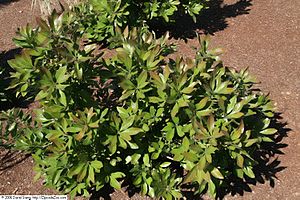Myrica caroliniensis facts for kids
Quick facts for kids Myrica caroliniensis |
|
|---|---|
 |
|
| Morella carolinensis 'Robbie Green' | |
| Scientific classification | |
| Genus: |
Myrica
|
| Species: |
caroliniensis
|
| Synonyms | |
|
|
Myrica caroliniensis is a cool plant, often called the southern bayberry. It's a type of shrub or small tree that grows along the coast and plains in the southeastern part of North America. You might also hear it called pocosin bayberry or evergreen bayberry. People use it in gardens, for making special candles, and sometimes even as a natural medicine.
Contents
What's in a Name?
Scientists give plants special names to help everyone know exactly what they're talking about. Myrica caroliniensis is one of several plants in the Myrica group. Sometimes, scientists put these plants into a different group called Morella.
This plant is very similar to the northern bayberry (M. pensylvanica). Northern bayberry usually loses its leaves in winter, while southern bayberry often keeps its leaves all year. Southern bayberry is also related to the wax myrtle (M. cerifera). You can tell them apart by their leaves. Wax myrtle leaves smell strong when you crush them, and they have tiny scent glands on both sides. Bayberry leaves have scent glands mostly on the underside and don't smell as strong. These two plants can even mix and create new kinds of plants!
What Does Southern Bayberry Look Like?
Southern bayberry is a shrub or small tree. It can grow in many different places, from sandy dunes to wet, swampy areas called pocosins. It especially likes wetlands.
You can find this plant growing naturally from Texas all the way up the U.S. east coast to Maryland. It's hard to tell it apart from the northern bayberry, which grows further north into Canada.
Southern bayberry usually stays green all year, or its leaves might fall off very late in the season. It spreads by sending out underground stems called rhizomes, which form new plants. This helps it create large groups of plants. Its leaves are long, feel a bit leathery, and have jagged edges. They also have tiny glands.
Reproduction and Flowers
This plant is dioecious. This means that male and female flowers grow on separate plants. Male plants have flowers with three to five stamens (the parts that make pollen). Female plants have flowers that turn into small, round fruits. These fruits are covered in a waxy coating. The plant flowers from spring to early summer, and its fruits appear in late summer or fall.
Special Roots
Bayberry is a special kind of plant called an actinorhizal plant. Its roots have tiny bumps called nodules. Inside these nodules live tiny helpers called actinobacteria (a type of bacteria) from the Frankia group. These bacteria help the plant take nitrogen from the air and turn it into food for the plant. This is called nitrogen fixation. Because of this, bayberry can grow well in poor, acidic soils, like those found in wetlands and dunes, where other plants might struggle.
Food for Wildlife
The waxy fruits of the bayberry are a great food source for many birds. Birds like the northern bobwhite quail and the wild turkey eat them. In winter, the fruits are very important for birds like the Carolina wren and different kinds of tree sparrows. Bayberry plants also provide a safe place for northern bobwhite quail to live. When birds eat the fruits, their digestive systems help remove the wax. This is important because the wax needs to be gone for the seeds to sprout and grow into new plants.
Uses of Southern Bayberry
In the Garden
Southern bayberry is often used in gardening and horticulture. People like to plant it because it's an attractive shrub that can grow in many different conditions.
Making Candles
The fruits of the southern bayberry are famous for making old-fashioned bayberry candles. These candles are a traditional Christmas decoration. To get the wax, people would boil the berries. The wax would float to the top, and they would skim it off. This wax was then boiled again and strained to make it clean. After that, the clean liquid wax could be used to make candles by dipping wicks into it or by pouring it into molds. Other plants related to southern bayberry can also be used to make these candles.
Today, most bayberry candles you find are not made from real bayberry wax. They are often made from paraffin wax with artificial colors and special smells added. These candles are made to look and smell like the natural ones.

